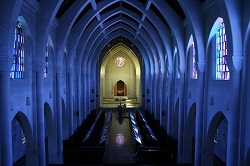 Yes. A full performance of the entire special service in the Russian Orthodox Church can indeed last pretty much all night, but be aware that the time is filled with much more than music–litanies (petitions and responses), Scripture readings, prayers, etc. A composer wouldn’t have to come up with hours and hours of music. Also, the service is often/usually cut, with the full version being performed very rarely.
Yes. A full performance of the entire special service in the Russian Orthodox Church can indeed last pretty much all night, but be aware that the time is filled with much more than music–litanies (petitions and responses), Scripture readings, prayers, etc. A composer wouldn’t have to come up with hours and hours of music. Also, the service is often/usually cut, with the full version being performed very rarely.
On the following day, the majority of those who participated in the service described themselves as almost intoxicated all throughout the all-night vigil. No one mentioned having been tired. One of the singers stated that he could sing another such vigil service then and there. One student, a lover of sleep, left the church several times, undressed and lay down on his bed, but, unable to fall asleep because he knew that a few steps away such an original, unheard of service was taking place, he returned to the church. (Read the entire article at “Description of a ‘Real” All-Night Vigil in Russia.” Parts of it are pretty technical and can be skimmed.)
Rachmaninoff’s masterpiece was not written until 1915, so it was not his music that was used in the above performance. A set service in a liturgical church, whether it be the Russian Orthodox Church, as here, or the Roman Catholic Church, or the Episcopalian Church, or any other, has certain texts, chants and songs that are performed in a certain order on certain occasions. Within this structure, composers have written music that can be part of the service but can also be performed outside of the church. So it is with Rachmininoff. There are fifteen parts to the Vigil, which is sometimes erroneously called simply the “Vespers.” But only six of those parts actually belong to the canonical hour called “vespers.” And what is a “canonical hour”? Well, as explained by our good buddy Wikipedia:
In the practice of Christianity, canonical hours mark the divisions of the day in terms of periods of fixed prayer at regular intervals. The practice of daily prayers grew from the Jewish practice of reciting prayers at set times of the day: for example, in the Book of Acts, Peter and John visit the temple for the afternoon prayers
To begin with there were eight canonical hours including the “Night Office,” also called the “Vigils.” Vespers is (yes, “is”) the evening prayer. If you were a monk or a nun in the Middle Ages you would have had to get up around 2:00 AM for Vigils.. Then you’d go back to bed for a few hours. Then you’d get up again for Lauds, the sunrise service. Throughout the day you’d have six other prayer services There are still a few institutions that observe these practices today, even in the US, although most places have abandoned that middle-of-the-night service. Do you find all this as fascinating as I do? Well, maybe not. But if you do, I’d direct you to a couple of very interesting sources. First, if you’d like to read about the life of a modern monk, then Thomas Merton is your guy. His autobiography, The Seven Storey Mountain, is considered a classic in the area of spiritual literature. But if you want something a little lighter, you might take a look at the Dame Frevisse mysteries by Margaret Frazer, set in a 15th-century English convent. Writing this post reminded me of those wonderful books, and I now have the audio version of the first one, The Novice’s Tale, loaded up on my phone. It’s going to be a great pleasure for me to revisit Dame Frevisse and her sisters. I love how Frazer makes her characters very human and yet totally in love with their spiritual life at the same time. For the purposes of my subject here, I will say that the books’ plots are always being interrupted by bells sounding for the next service. Occasionally Dame Frevisse gets permission to miss one if there’s an emergency going on, such as a murder.
Back to Rachmaninoff and his music. That first performance in 1915 took place as a benefit for the Russian war effort. It was so warmly received that it had five more performances within a month. (It’s not clear to me, though, whether or not the whole hours-long service was presented or only the music.) The music in parts is quite . . . challenging, shall we say. At one point the choir is divided into eleven parts. At another place the basses have to sing a low B-flat, the third such note below middle C. Wow! Rachmaninoff said that:
Danilin [the conductor] shook his head, saying, “Now where on earth are we to find such basses? They are as rare as asparagus at Christmas!” Nevertheless, he did find them. I knew the voices of my countrymen..
Russian basses are known for their low reverbs, aren’t they?
I won’t post a video of the whole thing below. Instead, here’s one section from the “Vespers,” sung by a amazing group in the Warsaw Cathedral. I cannot believe that this is only eight voices! (That final bass note may be the one mentioned above; I’m afraid that my perfect pitch is nonexistent. But it’s pretty low, whatever it is!)
© Debi Simons

